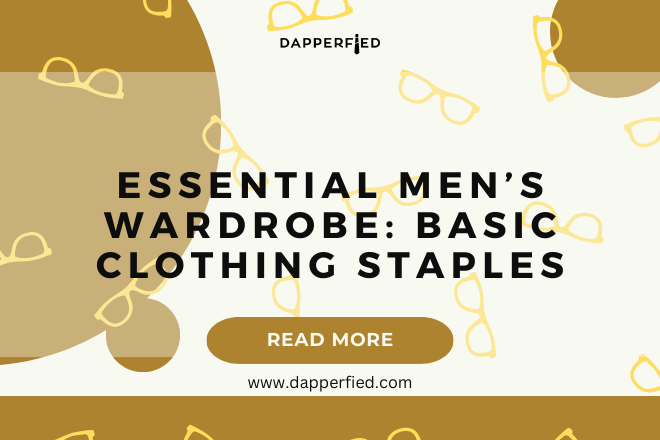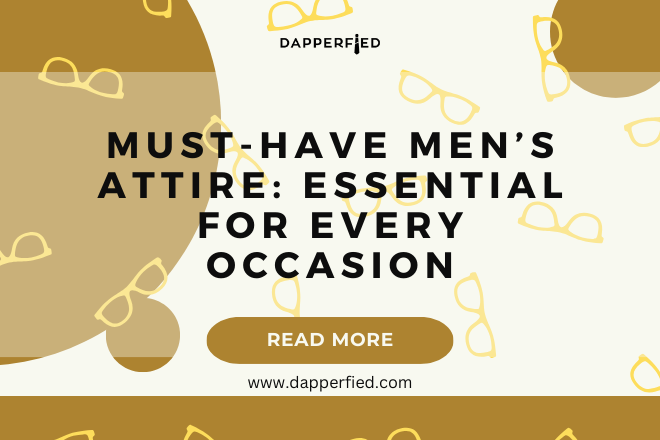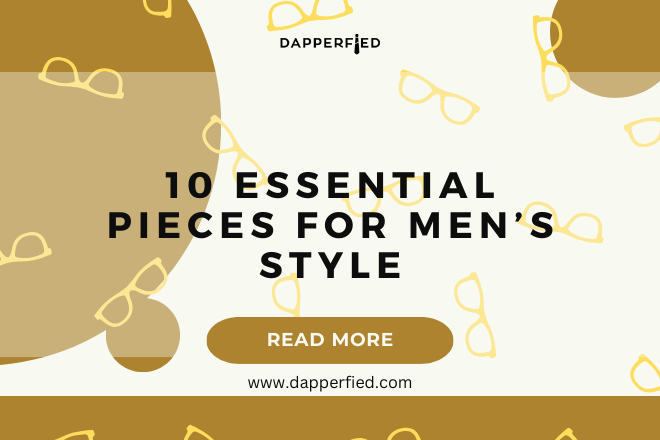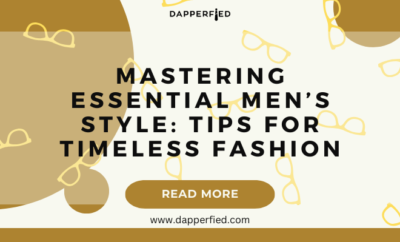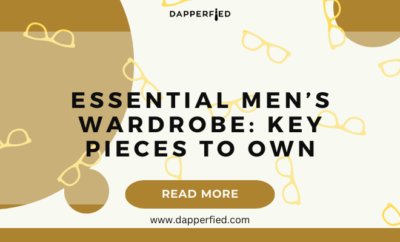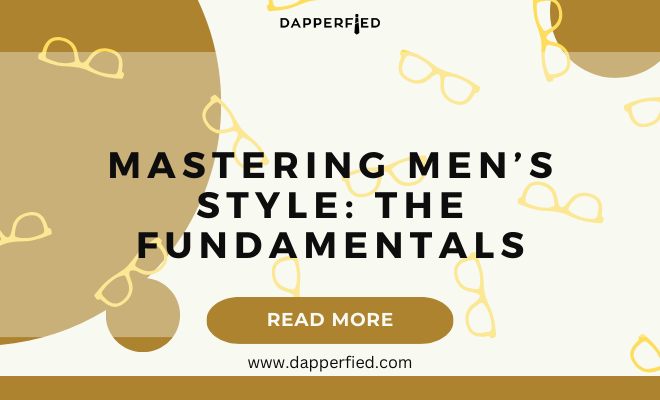
Men's Style
Mastering Men’s Style: The Fundamentals
Men’s style is often overlooked or dismissed as unimportant, but the truth is that how a man presents himself can have a significant impact on his confidence and success. The way a man dresses can influence how others perceive him and can even affect his own self-perception. When a man feels good about how he looks, he exudes confidence and is more likely to succeed in various aspects of his life, whether it be in his career, relationships, or personal endeavors.
Key Takeaways
- Understanding the basics of men’s style is crucial for building a wardrobe that reflects your personal taste and lifestyle.
- Building a men’s wardrobe from scratch requires investing in versatile pieces that can be mixed and matched to create different outfits.
- The importance of fit cannot be overstated in men’s fashion, as ill-fitting clothing can ruin an otherwise stylish outfit.
- Choosing the right colors for men’s clothing involves understanding your skin tone and experimenting with different shades to find what works best for you.
- Accessorizing men’s outfits can elevate a look and add personality, but it’s important to not overdo it and keep it appropriate for the occasion.
Understanding the Basics of Men’s Style
Men’s style encompasses more than just fashion trends; it is about expressing one’s individuality and personal taste through clothing and accessories. It is about understanding the different elements of style, such as fit, color, and accessories, and using them to create a cohesive and polished look.
Fit is perhaps the most important aspect of men’s style. Ill-fitting clothing can make even the most expensive outfit look sloppy and unflattering. It is crucial to find clothing that fits well and flatters your body type. This may require alterations or seeking out brands that offer a wide range of sizes.
Color is another important element of men’s style. Different colors can evoke different emotions and convey different messages. It is important to choose colors that complement your skin tone and personal style. Experimenting with different colors can help you find what works best for you.
Accessories are the finishing touches that can elevate a men’s outfit from ordinary to extraordinary. They can add personality and flair to an otherwise simple ensemble. From watches to belts to pocket squares, accessories allow you to express your individuality and make a statement.
Building a Men’s Wardrobe from Scratch
Building a men’s wardrobe from scratch can be overwhelming, but with some careful planning and budgeting, it can be done successfully. The key is to invest in basics and versatile pieces that can be mixed and matched to create a variety of outfits.
Start by investing in quality essentials such as a well-fitting suit, a few dress shirts, a pair of dress shoes, and a versatile blazer. These items will form the foundation of your wardrobe and can be dressed up or down depending on the occasion.
Once you have the basics covered, you can start adding more casual pieces such as jeans, t-shirts, and sweaters. Look for items that can be easily layered and mixed with your existing wardrobe.
Budgeting is an important aspect of building a wardrobe. Determine how much you are willing to spend and prioritize certain items. It is better to invest in quality pieces that will last longer rather than buying cheap items that will need to be replaced frequently.
The Importance of Fit in Men’s Fashion
| Metrics | Importance |
|---|---|
| Confidence | A well-fitted outfit can boost confidence levels and make a positive impression. |
| Comfort | Proper fit ensures comfort and ease of movement, allowing for better performance and productivity. |
| Style | A good fit enhances the overall style and appearance of an outfit, making it look more polished and put-together. |
| Durability | Clothing that fits well is less likely to wear out quickly or require frequent alterations, saving time and money in the long run. |
| Professionalism | In professional settings, a well-fitted suit or dress shirt can convey competence and attention to detail. |
Fit is crucial in men’s fashion because it can make or break an outfit. Ill-fitting clothing can make you look sloppy and unprofessional, while well-fitting clothing can enhance your appearance and boost your confidence.
When it comes to shirts, make sure the shoulder seams align with your shoulders and the sleeves hit just above the wrist bone. The shirt should fit comfortably around the chest and waist without being too tight or too loose.
For pants, pay attention to the rise, which is the distance between the crotch and waistband. The rise should be comfortable and not too low or too high. The pants should fit well around the waist and hips without being too tight or too loose.
When it comes to jackets and blazers, make sure they fit well in the shoulders and chest. The length should hit just below the hip bone, and the sleeves should hit just above the wrist bone.
If you are unsure about how something should fit, don’t hesitate to seek out a professional tailor who can help you achieve the perfect fit.
Choosing the Right Colors for Men’s Clothing
Color plays a significant role in men’s fashion as it can evoke different emotions and convey different messages. It is important to choose colors that complement your skin tone and personal style.

Start by determining your skin tone. Are you warm-toned or cool-toned? Warm-toned individuals tend to have yellow or golden undertones, while cool-toned individuals have pink or blue undertones.
Once you have determined your skin tone, you can choose colors that will flatter you. Warm-toned individuals tend to look best in earthy tones such as browns, oranges, and greens. Cool-toned individuals, on the other hand, tend to look best in jewel tones such as blues, purples, and greens.
Of course, personal style also plays a role in color choice. If you prefer a more classic and timeless look, neutrals such as black, white, gray, and navy are always a safe bet. If you are more adventurous and like to make a statement, don’t be afraid to experiment with bold colors and patterns.
Accessorizing Men’s Outfits: A Guide

Accessories are the finishing touches that can elevate a men’s outfit from ordinary to extraordinary. They allow you to express your individuality and make a statement.
When it comes to accessories, less is often more. Choose one or two key pieces that complement your outfit rather than piling on multiple accessories that can overwhelm your look.
Watches are perhaps the most popular accessory for men. They not only serve a practical purpose but also add a touch of sophistication and style to any outfit. Invest in a quality watch that suits your personal taste and can be worn with a variety of outfits.
Belts are another essential accessory for men. They not only hold up your pants but also add a polished finishing touch to your look. Choose a belt that matches the color of your shoes for a cohesive and put-together appearance.
Other accessories such as ties, pocket squares, and cufflinks can add personality and flair to a suit or dress shirt. Experiment with different patterns, colors, and textures to find what works best for you.
Dressing for Different Occasions: Casual, Business, and Formal
Dressing appropriately for different occasions is essential to make a good impression and feel confident in any setting. Understanding the different dress codes for various occasions can help you navigate the world of men’s fashion with ease.

Casual attire is typically the most relaxed dress code and allows for more personal expression. It is important to still look put-together and polished even in casual settings. Opt for well-fitting jeans or chinos paired with a button-down shirt or polo shirt. Add a blazer or sweater for a more elevated look.
Business attire is typically more formal and requires a more professional appearance. A well-fitting suit in a classic color such as navy or gray is a must-have for any man’s wardrobe. Pair it with a dress shirt, tie, and dress shoes for a polished and professional look.
Formal attire is typically reserved for special occasions such as weddings or black-tie events. A tuxedo or formal suit is required for these occasions. Pay attention to the details such as cufflinks, pocket squares, and bow ties to add a touch of elegance to your look.
The Art of Layering in Men’s Fashion
Layering is not only practical but also adds depth and visual interest to an outfit. It allows you to create different looks by combining different pieces of clothing.
Start with a base layer such as a t-shirt or dress shirt. Add a sweater or cardigan for warmth and style. Finish off with a jacket or blazer for a polished and put-together look.
When layering, pay attention to proportions and textures. Make sure each layer is visible and adds something unique to the overall look. Experiment with different combinations to find what works best for you.
Styling Men’s Hair and Grooming Tips
Grooming is an important aspect of men’s fashion as it can enhance your overall appearance and boost your confidence. Taking care of your hair and maintaining proper grooming habits can make a significant difference in how you look and feel.
Start by finding a hairstyle that suits your face shape and personal style. Consult with a professional hairstylist who can recommend the best haircut for you. Invest in quality hair products that will keep your hair looking healthy and styled.
In addition to hair, pay attention to other grooming habits such as shaving or grooming facial hair, taking care of your skin, and maintaining good hygiene. These small details can make a big difference in how you present yourself.
Investing in Quality Men’s Clothing and Accessories
Investing in quality clothing and accessories is essential for building a stylish and long-lasting wardrobe. While it may be tempting to buy cheap items, they often do not last as long and may need to be replaced frequently.
When shopping for clothing, pay attention to the fabric, construction, and brand reputation. Look for natural fibers such as cotton or wool, as they tend to be more durable and comfortable. Check the stitching and seams to ensure they are well-made and will withstand regular wear.
When it comes to accessories, invest in timeless pieces that will never go out of style. Classic items such as a quality watch or leather belt will last for years and can be worn with a variety of outfits.
Staying Up-to-Date with Men’s Fashion Trends
While it is important to have a personal style that reflects your individuality, staying current with men’s fashion trends can help you incorporate new ideas into your wardrobe.
Follow fashion influencers or browse fashion magazines to stay up-to-date with the latest trends. However, it is important to remember that not all trends will suit your personal style or body type. Choose trends that resonate with you and incorporate them into your wardrobe in a way that feels authentic.
Men’s style is more than just fashion; it is about expressing your individuality and personal taste through clothing and accessories. By understanding the basics of men’s style, building a wardrobe from scratch, paying attention to fit and color, accessorizing appropriately, dressing for different occasions, mastering the art of layering, styling hair and grooming properly, investing in quality clothing and accessories, staying up-to-date with fashion trends, you can elevate your style and boost your confidence. Start implementing these tips into your own style and watch as your confidence and success soar.
If you’re looking to elevate your men’s style game, understanding the fundamentals is key. From choosing the right accessories to mastering the art of tailoring, there are many aspects to consider. In a recent article on Dapperfied, they delve into the world of antique pocket watches and reveal 10 things you probably didn’t know about them. This fascinating read not only provides historical insights but also offers tips on how to incorporate these timeless pieces into your modern wardrobe. So, if you’re ready to add a touch of sophistication to your style, check out this article on antique pocket watches here.
FAQs
What are men’s style fundamentals?
Men’s style fundamentals refer to the basic principles and elements of dressing well, including fit, color coordination, and accessorizing.
Why are men’s style fundamentals important?
Men’s style fundamentals are important because they help men look their best and feel confident in their appearance. Dressing well can also have a positive impact on personal and professional relationships.
What are some key elements of men’s style?
Some key elements of men’s style include well-fitting clothing, appropriate color coordination, accessorizing with items such as watches and belts, and paying attention to grooming and hygiene.
How can men improve their style?
Men can improve their style by investing in quality clothing that fits well, experimenting with different colors and patterns, accessorizing appropriately, and seeking advice from fashion experts or style-conscious friends.
What are some common style mistakes men make?
Some common style mistakes men make include wearing clothing that is too baggy or too tight, failing to coordinate colors properly, wearing outdated or inappropriate clothing, and neglecting grooming and hygiene.
What are some timeless style tips for men?
Some timeless style tips for men include investing in quality clothing that fits well, choosing classic pieces that can be worn in a variety of settings, accessorizing with simple and understated items, and paying attention to grooming and hygiene.




